Pharmaceutical Waste Management
Pharmaceutical Waste Management. Leslie Durrant, R.Ph., BCPS , and Nancy Dietz, R.Ph., Ph.D. Harry S. Truman Memorial Veterans Hospital Columbia, Missouri. Harry S Truman Memorial VA Hospital Columbia, Mo. 100 Inpatient beds, 30,000 veterans. What is a hazardous drug?.
Share Presentation
Embed Code
Link
Download Presentation
- unused epinephrine
- d toxicity lists
- d drugs
- missouri
- large qty generator
- primary ways drug waste

aviv + Follow
Download Presentation
Pharmaceutical Waste Management
An Image/Link below is provided (as is) to download presentation Download Policy: Content on the Website is provided to you AS IS for your information and personal use and may not be sold / licensed / shared on other websites without getting consent from its author. Content is provided to you AS IS for your information and personal use only. Download presentation by click this link. While downloading, if for some reason you are not able to download a presentation, the publisher may have deleted the file from their server. During download, if you can't get a presentation, the file might be deleted by the publisher.
Presentation Transcript
- Pharmaceutical Waste Management Leslie Durrant, R.Ph., BCPS, and Nancy Dietz, R.Ph., Ph.D. Harry S. Truman Memorial Veterans Hospital Columbia, Missouri
- Harry S Truman Memorial VA Hospital Columbia, Mo. • 100 Inpatient beds, 30,000 veterans
- What is a hazardous drug? • ASHP 2004 TAB criteria for considering a drug hazardous (adopted by OSHA): • Carcinogenicity • Teratogenicity • Fertility impairment • Serious organ toxicity at low doses • Genotoxicity NIOSH criteria: 2004: ASHP’s criteria plus “Structure and toxicity profile of new drugs that mimic existing drugs determined hazardous by above criteria.”
- NIOSH • Now updating their list of hazardous drugs. 59 proposed additions. • Update is controversial: some proposed drugs are toxic only after prolonged oral usage such as divalproex, aripiprazole, amiodarone. • ASHP proposes further study on 40% of the proposed drugs before recommending handling as “hazardous drugs”.
- Hazardous Drugs: • Each facility should create its own list of “hazardous drugs” based upon criteria. NIOSH list may be useful in establishing a hospital list. MSDS, literature very helpful.
- Hazardous pharmaceutical Waste • Hazardous pharmaceutical waste is NOT synonymous with hazardous pharmaceuticals. • Some drugs not considered hazardous drugs by NIOSH,OSHA and NIH are still regulated as hazardous waste by EPA-RCRA. • Some drugs not considered hazardous waste under RCRA are probable environmental hazards (some chemo).
- Pharmaceutical Waste: • Two main types of pharmaceutical waste: hazardous and non-hazardous. • Hazardous waste as defined by EPA RCRA is waste with properties making it dangerous or potentially harmful to human health or the environment, and includes chemicals and drugs.
- Hazardous Pharmaceutical Waste under RCRA: Two primary ways drug waste is hazardous waste under RCRA: • It contains a “P” or “U” listed waste as the sole active ingredient • OR • It exhibits at least one “Characteristic” of a hazardous waste.
- Hazardous Pharmaceutical Waste under RCRA: In addition to exhibiting a “characteristic” or Listing as a P, or U, “listed” waste, three more requirements: • It has not been excluded by federal or state law, and • It has not been used for its intended purpose, and • The decision has been made to discard it.
- EPA - RCRA Listings • RCRA, P, U, lists originally developed for discarded commercial chemical products. • Listings only apply to pharmaceuticals that contain the listed drug as the “sole active ingredient”. E.g. – pharmaceuticals flavored by saccharin with other ingredients added would NOT be considered hazardous waste under RCRA.
- P list – Acutely Hazardous
- P Listed waste generation: • Large qty generator: produces more than 1 Kg (2.2 lbs) per calendar month. • Small qty generator: < 1 Kg/month. • Conditionally exempt small quantity. • Most hospitals fall into small or large quantity generator category.
- To reduce P waste generation: • Practice waste minimization: Minimize inventory, “just in time” ordering. • Purchase unit dose whenever possible on P listed items. • Repackage minimal amounts at a time. • Encourage patient to take home appropriately Rx labeled partial bulk containers.
- Nitroglycerin:
- Nitroglycerin • Nitroglycerin in finished dosage forms is exempt by EPA/RCRA (2001). • Some states have adopted this exemption, including Missouri, Iowa, and Alaska. • Some states, such as Michigan, have chosen not to adopt. Check with your state.
- Epinephrine
- Epinephrine in syringes: • Missouri DNR Hazardous Waste Program: epinephrine in a discarded syringe is not a P listed waste. • Rationale: once the syringe has been used for patient care, it has been used for its intended purpose. • Applies to partially used epinephrine IV admixtures, also per Mo DNR. • RCRA: applies to any P or U listed drug in a syringe as waste, after patient use.
- Epinephrine in syringes: • Epinephine syringes after emergency use (e.g. Code Blue): discard in sharps container. • EXPIRED unused epinephrine STILL considered P listed waste.
- Warfarin:
- Warfarin: • If present in dosage forms over 0.3%, the whole preparation is a “P” listed pharmaceutical waste when decision is made to waste. • Tablet weighings demonstrated that all of the common tablet strengths are >0.3% warfarin, and therefore P waste when discarded. • 5mg/210mg (tablet weight) = 2.4%
- Nicotine:
- Nicotine: • Patch dosage forms: after patient use, consider “used”? Or “unused”? • Expired unused may be returned to reverse distributor for credit. • Patient home disposal not regulated by RCRA.
- U List – Toxic Wastes
- D list: Characteristic waste • Waste exhibits one of 4 characteristics of hazardous wastes: 1. ignitability – 2. corrosivity – 3. reactivity - 4. toxicity – if concentration of chemical above regulatory level in mg/L.
- Characteristic Waste: • The generator (the hospital) is responsible for deciding if a drug product that is being discarded exhibits a characteristic. • Decision is based upon testing or knowledge of the drug product properties. • MSDS, pharmacy references and literature can help determine this.
- Characteristic waste: Toxicity
- Toxicity characteristic • Mercury: most vaccines reformulated and now preservative free. • Silver: present in silver sulfadiazine cream, silver nitrate sticks. • Barium: in contrast media. Radiology is a satellite accumulation point.
- Chemotherapy • Only seven chemotherapy drugs on the U list. However, RCRA was enacted in 1976 and the list has not been updated since then. • Most hospital consider all cytotoxic chemotherapy to be hazardous waste, including our VA hospital.
- Putting it all together: • Receipt into pharmacy: As the medication order received is sorted, medications that could become hazardous wastes are placed into specially labeled bins:
- Repackaging: • As drugs that could become hazardous waste are repackaged, a code is included on the label for Nursing notification: ”HW-P list”
- Re-packaged drug: • “HW-P List”: text chosen to alert Nurse, but not alarm Veteran:
- Dispensing: Before dispensing, a drug that could become hazardous waste Has the code included on the barcode label:
- Patient discharge: • Partial bulk medication that could become hazardous waste, if prescribed at discharge, is re-labeled and given to the patient during discharge counseling by the Pharmacist.
- Reverse Distributors • Receive outdated drugs (“products”) from pharmacies and ship to manufacturer for credit. • Outdates not meeting manufacturer’s policy become “waste” once the RD makes the decision to discard. • EPA supports this practice as long as it is not the sole waste management practice.
- Disposal: P,U, or D listed items
- “P” Bucket: Satellite accumulation
- P,U, and D buckets:Satellite accumulation Point • Pharmacy satellite accumulation point:
- Satellite accumulation: List of all contents with dates required:
- Satellite Accumulation: • Satellite storage up to 1 year before sending to facility hazardous waste storage area, unless > 1 quart of P listed or 55 gallons of hazardous waste. • Industrial Hygienist utilizes licensed hazardous waste contractor to pick up from facility hazardous waste area.
- Disposal: Chemotherapy
- Trace Chemo:
- Bulk Chemo: • Contains: expired and partially used vials, IV bags. • Grossly contaminated items • Spill clean up material • Must label bucket as “Chemotherapy” AND “Hazardous waste”. Must include names of EACH drug within, and date 1st waste placed. Keep closed!
- Disposal: non hazardouspharmaceuticals:
- Take home points: • Know P, U, and D toxicity lists. • Know State law. • Label all P, U, and D drugs as “HW” all through chain from receipt to final dispensing or segregation for pickup. • Implement safe handling practices and policies for hazardous drugs. • Questions?

Pharmaceutical Waste Management
Agenda. Why does my facility need an Rx Waste Program?EnvironmentRegulationsWhat is Rx Waste?Elements of a Full Service Rx Waste ProgramWaste characterizationWaste collection
956 views • 46 slides

Pharmaceutical Waste Program
Pharmaceutical Waste Program. Portland Service Area 2011. What is Pharmaceutical Waste?.
848 views • 29 slides
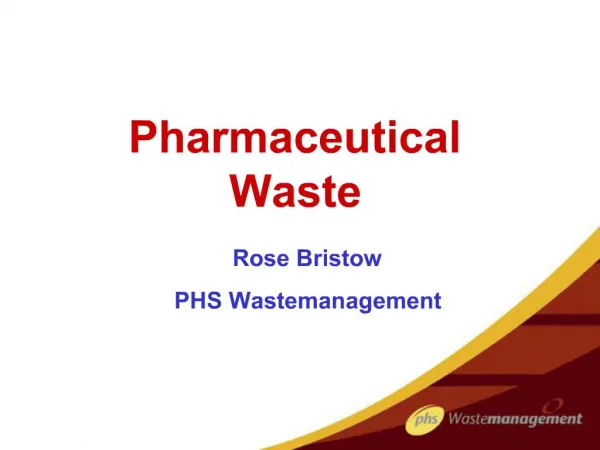
Pharmaceutical Waste
Been in clinical waste market since 1963Specialist in Healthcare,chemical and hazardous waste collection, treatment and disposal Contracts include NHS and Private Sector Private Key Accounts include :- Boots,Lloyds, Rowlands,Asda,Morrisons,Calea. About PHS Wastemanagement. Devon/Plymouth/Torba
572 views • 23 slides

Waste Management
Waste Management. Department of Fisheries and Aquatic Resources (DFAR) Sri Lanka. National Aquatic Resources Research and Development Agency (NARA) Sri Lanka. United Nations University Fisheries Training Programme (UNU-FTP) Iceland. Icelandic International Development Agency (ICEIDA)
1.67k views • 27 slides

Waste Waste Management
1.33k views • 17 slides
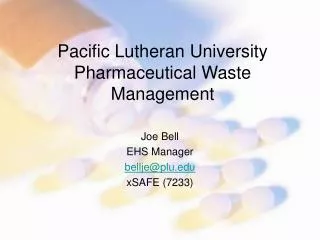
Pacific Lutheran University Pharmaceutical Waste Management
Pacific Lutheran University Pharmaceutical Waste Management. Joe Bell EHS Manager bellje@plu.edu xSAFE (7233). Universe of Waste. Discarded Materials. Products used for their intended purpose (not waste). Solid Waste. Dangerous Waste. Pharmaceutical Waste. RCRA Hazardous Waste.
423 views • 30 slides

Pharmaceutical Waste Management & Minimization
Pharmaceutical Waste Management & Minimization . Janet Bowen, EPA March 26, 2008. Overview of Presentation. Environmental impacts of prescription drugs Review of 10-Step Blueprint including Regulatory Requirements
1.07k views • 58 slides

Hazardous Pharmaceutical Waste Disposal
Hazardous Pharmaceutical Waste Disposal. Why do we care about pharmaceutical waste?. -To protect humans and the environment-increasing evidence of harm from even very small amounts of some pharmaceuticals, particularly in fetal and newborn development -To be a good citizen/steward
171 views • 11 slides
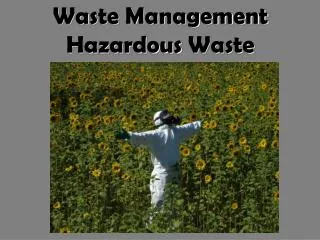
Waste Management Hazardous Waste
Waste Management Hazardous Waste. The topics of today. Rules and regulations Hazardous Waste Dangerous Goods Security advisement The work of SEKA Miljöteknik Laboratory waste Questions , comments , views and ideas. Askewed balance - Environmental changes. Organization.
1.09k views • 27 slides

Pharmaceutical Waste
Pharmaceutical Waste. It is the law – managers to the CEO can be held liable. Pharmaceuticals are being found in drinking water across the country. Endocrine disruptors are suspected of causing feminization of fish.
498 views • 8 slides

RCRA and Pharmaceutical Waste Management: A Brief Federal Overview
RCRA and Pharmaceutical Waste Management: A Brief Federal Overview. Lisa Lauer (EPA) Office of Resource Conservation and Recovery Lauer.lisa@epa.gov ; 703-308-7418. What is RCRA?. RCRA = Resource Conservation and Recovery Act Goals:
420 views • 22 slides

Waste Management
Waste Management. External Supplier User Guide. SciQuest USA, Inc 5433 Westheimer Ste 925 Houston, TX 77056 1-800-233-1121. Table of Contents. Getting Started. 3
505 views • 19 slides

Pharmaceutical Waste Management
Pharmaceutical Waste Management. Leslie Durrant, R.Ph., BCPS , and Nancy Dietz, R.Ph., Ph.D. Harry S. Truman Memorial Veterans Hospital Columbia, Missouri. Harry S Truman Memorial VA Hospital Columbia, Mo. 100 Inpatient beds, 30,000 veterans. What is a hazardous drug?.
1.14k views • 44 slides

Pharmaceutical Waste Management
Pharmaceutical Waste Management. PARAS SHAH. Waste & Effluents (E/C PCB). Bio-Medical Waste (Management and Handling) Rules, 1996 Additional precaution for storage and disposal of rejected drugs Records Proper and safe storage of waste materials awaiting disposal.
728 views • 20 slides
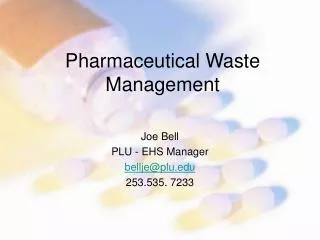
Pharmaceutical Waste Management
Pharmaceutical Waste Management. Joe Bell PLU - EHS Manager bellje@plu.edu 253.535. 7233. Universe of Waste. Discarded Materials. Products used for their intended purpose (not waste). Solid Waste. Dangerous Waste. Pharmaceutical Waste. RCRA Hazardous Waste. Universal Waste.
856 views • 35 slides

Pharmaceutical Waste Management Program
Pharmaceutical Waste Management Program. University of Chicago Medical Center. Introduction. University of Chicago Medical Center (UCMC) will be implementing a program to collect Pharmaceutical (Rx) waste throughout the hospital.
1.04k views • 29 slides

Pharmaceutical Waste Disposal - www.medalliancewm.com
Contact Med Alliance for any type of pharmaceutical waste disposal or visit at http://www.medalliancewm.com/services/pharmaceutical-destruction/ for more details.
248 views • 6 slides

Pharmaceutical Waste Destruction
Most of the pharmaceutical firms are adapting and following the rules of pharmaceutical waste destruction as they are being regularly monitored by the government.
296 views • 16 slides

Pharmaceutical waste disposal - emsllcusa
EMSLLC has the experience to handle all your pharmaceutical waste disposal needs. Our various outlets lets us customize a program which best suits your needs, whether it is non regulated OTC Materials, trace Chemotherapy drugs, or U & P Listed hazardous waste chemotherapy drugs.
116 views • 2 slides
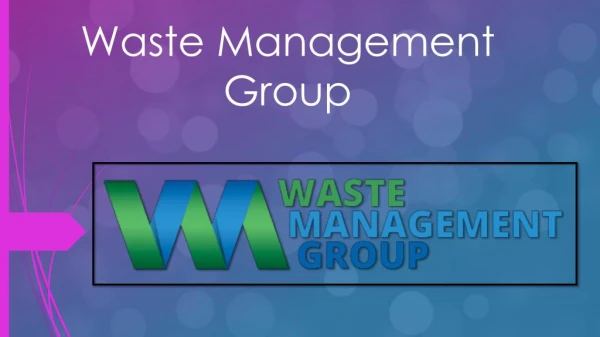
Waste Management Services-Waste Management Group
Waste Management Group are dedicated to finding alternative uses for all construction waste material. We care about our environment, and we are focused on becoming a market leader in the construction and demolition debris recycling industry. With Skip Bins and large volume Hook Bins for hire, and a centrally located Transfer Station in Molendinar, Waste Management Group provides a total waste and recycle service covering the Yatala to Northern Rivers. Professional and reliable, our services include prompt collection and recycle, or we accept and process commercial waste from waste collectors via our best guarantee tipping service.For More Info Check Our Website:-https://wmgroup.com.au
267 views • 9 slides

Affordable Pharmaceutical Waste Disposal Service
Medical Environment Technologies provides advanced pharmaceutical waste solutions to help the healthcare industry safely dispose of hazardous pharmaceutical waste. Our waste container program provides only the best in waste safety. Once the top is sealed, the container cannot be opened, it is leak proof. Visit us today for more details.

Pharmaceutical Waste Management
Pharmaceutical waste is also a medical waste that needs to be properly disposed of. It contains hazardous and toxic drugs that need to be disposed of properly to prevent the environment, people, animals, and all of the bio-life.Hence, proper pharmaceutical waste management is highly important and necessary for every healthcare organization or hospital.
205 views • 7 slides
























